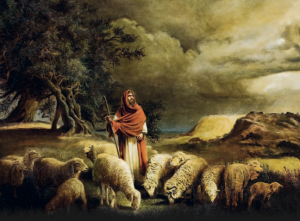‘Strike the shepherd and the sheep will scatter’ – Babatunde Olugboji
The shepherd theme is prevalent throughout Zechariah’s prophetic ministry (Zechariah 10:2; 11:4-14, 15-17). An example is in Zechariah 11:4-14, where the prophet foretells Israel’s impending rejection and subsequent death of the Messiah. In response to this, the Lord issues this profound command: ‘Strike the shepherd, and the sheep will be scattered, and I will turn my hand against the little ones’ (Zechariah 13:7).
According to the vision in Ezekiel 34, the sheep referenced in Zechariah’s prophecy represent God’s people. In the era of Ezekiel, the inhabitants of Judah were stripped of their ungodly leaders and scattered. During this period of exile, the Lord’s judgment was directed towards ‘the little ones’ as they faced dispersion and punishment. Additionally, God’s judgment was also aimed at false shepherds. However, the Shepherd mentioned in Zechariah 13:7 is markedly different from the misguided leaders of Israel; He is, in fact, the Messiah, Jesus Christ.
The term translated as ‘strike’ in Zechariah 13:7 signifies ‘to smite or kill.’ The violence against Israel’s Messiah-Shepherd is alluded to in Genesis 3:15, where God predicts that Satan will ‘strike his heel.’ A parallel verse to Zechariah 13:7 is Isaiah 53:10, which also foretells the suffering and death of the Messiah: ‘It was the Lord’s will to crush him and cause him to suffer’ (refer also to Isaiah 53:4). 
In the NT, Jesus references Zechariah 13:7 concerning His arrest, Peter’s denial, and the dispersion of His disciples (Matthew 26:31, 56). In John, Jesus declares, ‘I am the good shepherd. The good shepherd lays down his life for the sheep’ (John 10:11).
God’s command to ‘strike the shepherd and the sheep will scatter’ is multi-purposed. First, it reveals that Christ’s death was not an accident; it was part of God’s divinely arranged plan (Acts 2:23). Even still, God does not let the slaughter of His Son and Savior of the world go unpunished. Instead, He uses it as an instrument of judgment on sinful people (see John 3:19).
In Zechariah 13:1-6 the prophet illustrates the emergence of a cleansing fountain that removes sin and eradicates idolatry from the people. Following the striking of their Shepherd, the populace undergoes a purifying trial akin to gold refinement, ultimately restoring their covenant relationship with the Lord their God (Zechariah 13:9).
These verses foretell the restoration of Israel’s remnant (see Hosea 2:23) and a future reinstatement mentioned by Paul in Romans 11:11–32. They also extend through history, anticipating the periods of persecution faced by God’s people during the church age and the tribulation (Matthew 24:15–22).
In God’s divine order, justice must prevail. Sin incurs a death penalty and cannot remain unpunished; thus, Jesus has taken on himself the punishment for all (Romans 6:23; 1 Corinthians 15:21–22). Peter says, “Christ suffered for our sins once for all time. He never sinned, but he died for sinners to bring you safely home to God. He suffered physical death, but he was raised to life in the Spirit” (1 Peter 3:18,). 
From the moment of the fall, God’s ultimate plan to strike the Shepherd and scatter the sheep was the restoration and redemption of His people. Through the death of Christ, sinful people can be reconciled to God (Colossians 1:19–22). Jesus’ sacrifice on the cross washes away our sins and opens the way for the reinstatement of our relationship with the Father (Hebrew 2:17). Zechariah 14 closes with the final victory and defeat of every enemy as the Lord Jesus Christ reigns as King over all the earth.
Questions or comments?
Reach out on:
+1-732-554-1376 (WhatsApp)


